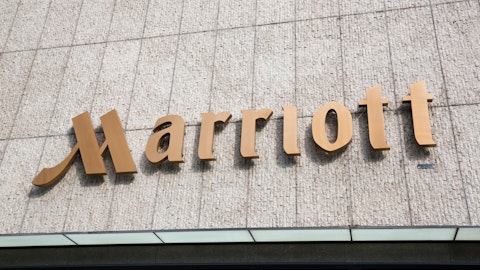Marriott International, Inc. (NASDAQ:MAR) Q3 2023 Earnings Call Transcript November 2, 2023
Marriott International, Inc. misses on earnings expectations. Reported EPS is $ EPS, expectations were $2.1.
Operator: Good day, everyone and welcome to today’s Marriott International Third Quarter 2023 Earnings Call. At this time, all participants are in a listen-only mode. Later, you will have the opportunity to ask questions during the question-and-answer session. [Operator Instructions] Please note, today’s call will be recorded and I’ll be standing by if you should need any assistance. It is now my pleasure to turn the call over to Jackie McConagha. Please go ahead.
Jackie McConagha: Thank you. Good morning and welcome to Marriott’s third quarter 2023 earnings call. On the call with me today are Tony Capuano, our President and Chief Executive Officer, Leeny Oberg, our Chief Financial Officer and Executive Vice President, Development; and Betsy Dahm, our Vice President of Investor Relations. Before we begin, I would like to remind everyone that many of our comments today are not historical facts and are considered forward-looking statements under Federal Securities Laws. These statements are subject to numerous risks and uncertainties as described in our SEC filings, which could cause future results to differ materially from those expressed in or implied by our comments. Please also note that, unless otherwise stated, our RevPAR occupancy and average daily rate comments reflect system-wide constant currency results for comparable hotels.
Statements in our comments and the press release we issued earlier today are effective only today and will not be updated as actual events unfold. You can find our earnings release and reconciliations of all non-GAAP financial measures referred to in our remarks today on our Investor Relations website. And now, I will turn the call over to Tony.
Tony Capuano: Thanks, Jackie. Thank you all for joining us today. We recorded terrific third quarter results this morning. Global demand for travel has remained strong and worldwide RevPAR of the quarter rose 9% versus 2022. RevPAR increased over 4% in the US and Canada and 22% internationally, driven by significant gains across Asia Pacific. Robust RevPAR growth, combined with nearly 5% year-over-year rooms growth, resulted in adjusted EPS of $2.11, up 25% from 2022. The third quarter tends to see a seasonally higher level of leisure transient travel, which accounted for 45% of global room nights during the quarter, about 4 percentage points above the first half. Globally, demand in this segment was, again, quite strong, with room nights up 7% over the 2022 third quarter, leading to 9% leisure transient revenue growth.
In the US and Canada, leisure revenues rose 4% from the year ago quarter, even as many domestic guests traveled to international locations, particularly in Europe and Asia Pacific. In the third quarter, leisure room nights from US and Canadian guests traveling outside the region were up nearly 25% over the last year when cross-border travel was still constrained by COVID-related restrictions. Business transient demand accounted for 32% of global room nights in the quarter, while certain industries like technology and finance saw nice sequential improvement in demand during the quarter. The overall growth per segment remained slow and steady, with business transient revenues rising 4% versus 2022 in the US and Canada. Global group room night-share stood at 23% in third quarter.
Compared to the year ago quarter, group revenues rose 9% globally and 5% in the US and Canada. The performance of group coming out of the pandemic has been remarkable, and the segment is expected to continue to be a meaningful driver of revenue growth going forward. In the US and Canada, fourth quarter 2023 group revenues were pacing up 12% year-over-year at the end of September, leading to full year group revenue pacing up 19%. Of course, we have the most visibility in the group, given the longer booking windows. We’re very pleased that as of the end of the third quarter, US and Canada group revenue on the books for 2024 were pacing up 14% versus 2023, driven by a 9% rise in room nights and a 5% increase in average rates. Cross-border travel continued to strengthen, helping drive RevPAR growth in the third quarter.
Asia Pacific, again, saw the most meaningful quarterly increase in international visitors, aided by global events like the Women’s World Cup and improved airlift. The percent of global room nights from cross-border guests was about 1 percentage point below 2019 levels of approximately 20%. The most upside is still expected to come in Asia Pacific as international airlift to China improves. International airlift in Greater China was roughly 50% of 2019 capacity at the end of the third quarter and is expected to improve to around 60% by the end of the year. Turning to our powerful Bonvoy loyalty program. We remain focused on driving membership and fostering engagement with our 192 million members. Through our multi-year company-wide digital and technology transformation, we are increasingly leveraging the power of our more modern platform to create more seamless, engaging digital experiences for our members.
Adoption of our Marriott Bonvoy mobile app, which has become the channel of choice for the majority of our lead members, continues to grow, with third-quarter app downloads increasing 19% versus the same quarter last year. We also continue to drive engagements for our Bonvoy collaborations, including Uber, Eat Around Town and our co-branded credit cards, which are currently in 11 countries. We’re very excited about the opportunities our Bonvoy customers will receive from our MGM strategic licensing arrangement, which is now expected to launch in early 2024. As we think about our net rooms growth, full year 2023 growth is now expected to be 4.2% to 4.5%, higher than our previous expectation, excluding the additional 37,000 MGMs. The MGM timing shift does not impact the three-year net rooms growth CAGR of 5% to 5.5% through 2025, that we lay down in our financial model at our September Analyst Day.
We are pleased that over the next few years, our net rooms growth is anticipated to be squarely in the mid-single digit range. During the quarter our pipeline reached a new record high of nearly 557,000 rooms, a record even excluding the MGM rooms. Strong interest in conversions continues, including multi-unit opportunities. Conversions represented 20% of signings and nearly 30% of openings in the quarter. As we outlined in our Analyst Day, we are very excited about the global opportunity for mid-scale. We have real momentum with the Citi Express brand in CALA, Four Points Express in Europe, and StudioRes in the US, with terrific interest across the development community. We already have 10 signed letters of intent for City Express in CALA, nine of which are in new countries for the brand, four signed deals for Four Points Express in Turkey and in London.

And we’re in numerous additional discussions for both brands. And while we just recently issued the franchise disclosure documents for StudioRes, we are already in talks for deals in over 300 markets across the US. We expect there will be shovels in the ground for StudioRes projects in the next few months. As a global company, we are keenly aware that we are living in a time of highly geopolitical tension. We are heartbroken by the devastating loss of so many innocent lives in the Israel-Hamas conflict. Our thoughts are with everyone impacted by this tragic war, as well as the ongoing war in Ukraine, and we remain hopeful for peace. I will now turn the call over to Lee to discuss our financial results in more detail.
Leeny Oberg: Thank you, Tony. Our strong third quarter results reflect solid momentum in our business around the world and came in ahead of our expectations. As Tony noted, worldwide RevPAR grew 9% above the top end of our guidance, led by meaningful gains in Asia Pacific. Global occupancy in the quarter reached 72%, 3 percentage points higher than a year ago, and global ADR continued to rise, growing 4%. Total company gross fee revenues totaled $1.2 billion, in line with our guidance and 13% above the prior year quarter. Fees would have been higher given our RevPAR performance, but for the negative impact of the wildfires in Maui, which primarily affected our IMFs. Total IMFs still grew meaningfully, rising 35% to $143 million in the quarter.
International IMFs rose nearly 60% benefiting from another quarter of significant RevPAR increases in Asia Pacific. Our non-RevPAR related franchise fees grew 8% to $208 million, boosted by another strong quarter for our co-brand credit cards, partially offset by lower residential branding fees. Co-brand credit fees rose 11% in the quarter, driven by another quarter of robust global card spend and new card acquisition. Our owned lease and other revenue, net of direct expenses reached $70 million in the quarter, given continued improved performance at our owned and leased hotel. With the operating leverage inherent in our business, adjusted EBITDA rose 16% to $1.14 billion. After another quarter of meaningful share buybacks, diluted adjusted EPS grew 25% year-over-year to $2.11.
Our powerful asset-light business model continues to generate a large amount of cash. And our capital allocation philosophy has not changed. We’re committed to our investment-grade rating, investing in growth that is accretive to shareholder value, while returning excess capital to shareholders through a combination of a modest cash dividend and share repurchases. In the first nine months of this year, we returned $3.4 billion to shareholders. Over the last seven years, which included two years of no share repurchases as a result of COVID, we have reduced our outstanding share count by 23%, while at the same time investing meaningfully in innovation and growth. Now, let’s talk about our fourth quarter and full year 2023 outlook, the full details of which are in our earnings press release.
While there is heightened geopolitical risk and continued macroeconomic uncertainty, the consumer is still generally holding up well and our forward bookings through the end of the year in most regions around the world remain solid. We’re raising our full-year RevPAR guidance to incorporate the better than anticipated third quarter results, as well as higher expectations for the fourth quarter. In the fourth quarter, RevPAR growth is expected to remain higher internationally than in the US and Canada, where we’ve seen a return to more normal seasonal patterns and year-over-year RevPAR growth is stabilizing. We now anticipate fourth quarter RevPAR growth of 3% to 4% in the US and Canada, and 14% to 16% internationally. This would lead to global RevPAR growth of 6% to 7.5% in the fourth quarter and 14% to 15% for the full year.
We now expect full year total gross fee revenues could rise 17% to 18% with fourth quarter gross fees benefiting a bit from the higher RevPAR expectation. This is expected to be partially offset by lower expected residential branding fees due to anticipated completion of certain projects slipping into next year, as well as a bit softer results in Israel and surrounding countries. We’ve started to see some cancellations and softer demand for our five hotels in Israel, as well as for the 27 hotels in Lebanon, Jordan, and Egypt. Fees for these four countries made up less than 1% of total company gross fees in full year 2022. We’ve not seen a meaningful impact on demand in the rest of the Middle East. We’re keeping a close eye on the situation and working closely with our teams from the ground as events unfold.
Total non- RevPAR related fees are expected to increase around 5% for the full year, benefiting from credit card fees rising roughly 10%, thanks to robust growth and average spend in the number of cardholders, partially offset by meaningfully lower residential branding fees this year versus our peak levels in 2022. Residential fees are tied to the sales of new units and tend to be lumpy as projects enter sales and closing spaces. Owned, leased and other net is now expected to be around $330 million for the full year, at the low end of our previous guidance range, primarily due to the restructuring of an existing lease on a hotel in New York that recently flipped to franchise. We expect 2023 G&A expenses to be around $935 million at the high end of our prior range, primarily due to higher compensation and legal expenses and to a lesser extent MGM integration costs.
Compared to 2022, full-year adjusted EBITDA could increase 19% to 20% and adjusted EPS could rise 27% to 28%. We expect to return between $4.3 billion and $4.5 billion to shareholders for the full year 2023. This now assumes full year investment spending of $900 million to $950 million, which includes the $100 million spent on the acquisition of the City Express brand portfolio. As we’ve discussed, with our major technology transformation, technology spending will be elevated this year and over the next few years, though this investment is overwhelmingly expected to be reimbursed over time. As we look into 2024, we continue to be enthusiastic about healthy global lodging demand for our brands and our strong pipeline growth. While we are still in the middle of putting together our property budgets for 2024, we believe the modeled global RevPAR range for 2024 of 3% to 6% we discussed at September Security Analyst Meeting is appropriate.
Thank you for your interest in Marriott. Tony and I are now happy to answer your questions.
See also 20 Least Diverse Countries in the World and 25 Most Dangerous Gangs in the US.
Q&A Session
Follow Marriott International Inc (NASDAQ:MAR)
Follow Marriott International Inc (NASDAQ:MAR)
Operator: [Operator Instructions] Our first question comes from Shaun Kelley with Bank of America. Please go ahead.
Shaun Kelley: Hi, good morning everyone. Thank you for taking my questions. Tony or Leeny, just wanted to maybe start with the development side. Obviously, the pipeline number was very strong. It did look like the in-construction number, I think, slipped very modestly quarter-on-quarter. So could you maybe help, first of all, just comment, big picture, Tony, on what you’re seeing on the development side, particularly in the US. And then secondarily, just any comments on how we should expect maybe that in-construction portion to evolve just as, again, the development environment kind of levels off here a little bit. Thank you.
Tony Capuano: Sure, Sean, I’ll try to talk maybe macro and then I might ask Leeny to chime in with some perspective on the financing climate, particularly here in the US and maybe some perspective on Europe, because those tend to be the two markets where our development partners rely most heavily on, conventional debt financing and the markets where we’re seeing the most constriction in the availability of financing for new construction. With that said, the ebb and flow of under-construction is both good and bad, right? As hotels open and we had a good quarter of openings. You see under-construction hotels leave the pipeline, because they enter the system that’s opening hotels, and that’s good news for us. We have talked over the last couple of quarters about, albeit a steady increase in the number of construction starts, which is good news for us, but that constriction in the debt markets that I talked about, precluding us from getting back to where we were pre-pandemic in terms of the pace of new construction starts, particularly here in the US.
At the same time, we are encouraged by the continued increase in the pace of conversion activity, both on individual conversions and portfolio conversions. And I think it’s that increased pace, coupled with a steady improvement in construction starts that gives us confidence in reaffirming the multi-year net unit growth numbers we shared with you last month during the Security Analyst Conference. And maybe with that, I’ll ask Leeny to just give a little more color on the financing environment.
Leeny Oberg: Yes, sure. So there is couple of comments overall, Shaun. One is, just a reminder that the under-construction component of our pipeline also very typically includes conversions that may be going through some element of renovation before they open. And so, it’s not quite the same as pre-COVID, which had a lower percentage of conversions for the company overall. So, as we’ve talked about before, we would expect, for example, perhaps roughly 30% of the openings in 2024 to be from conversions, which means, they can be in the pipeline a bit differently than the classic new build timing for being in the pipeline. So I think that the nature of the under construction pipeline could be perhaps a little bit different than pre-COVID.
But as Tony was describing, you’ve clearly got the reality that in Asia Pacific and a number of other markets, there is meaningfully less dependence on the debt markets. And those markets are seeing much more stereotypical signings and progress into rooms under construction. While in the US, what you see is that, there is clearly still an open financing market for strong brands, strong market locations, demonstrated developer success. And in those, we are absolutely continuing to see that the financing is happening and that the rooms are getting under construction. The main difference, I would say is, they’re taking a bit longer to actually get under construction. But as we kind of look going forward, the ones that are getting under construction are moving forward and then opening right on time.
So as Tony said, overall, we’re pleased to see the net rooms growth, for example, that we actually raised a bit for 2023, reflecting continued strong demand for our brands and also rooms getting finished and open, as well as really strong signings going into the pipeline. So overall, we’re actually quite pleased on the new rooms front.
Shaun Kelley: Thank you very much.
Operator: Thank you. Our next question will come from Joe Greff with JPMorgan. Please go ahead. And Joe, your line is open. Please go ahead with your question.
Jackie McConagha: Are you on mute, Joe? All right, let’s go to the next question.
Operator: Yes, we’ll take our next question from Stephen Grambling with Morgan Stanley. Please go ahead.
Stephen Grambling: Hey there, can you hear me?
Tony Capuano: Yes, good morning, Stephen.
Stephen Grambling: Good morning. I would love if you could put a little bit more meat on the bone for the 2024 RevPAR commentary, specifically if you can give any color on how you are thinking through North America versus other regions? And how these assumptions may impact incentive management fees or other fees in the next year? Thank you.
Leeny Oberg: Yes, sure. Thanks very much. As I mentioned in my comments, we continue to feel good about the 3% to 6% range that we discussed at the Security Analyst Meeting. It’s worth noting, however, Stephen, that we are smack in the middle of the process of building the budgets at the hotel level and moving up. So we’re not prepared to give kind of formal guidance at this point. But when we look, broadly speaking, at seeing continued demand for travel, and as we talk about in the US, we would expect that that will remain in this more normalized seasonal patterns that we’ve now come to see. You’ve seen our guidance for Q4 being 3% to 4%, which reflects that. But we’ve got some basic strong fundamentals. Low supply growth for several years, which looks to continue to be the way going into 2024, and that’s reflected in our higher percentage of conversions.





